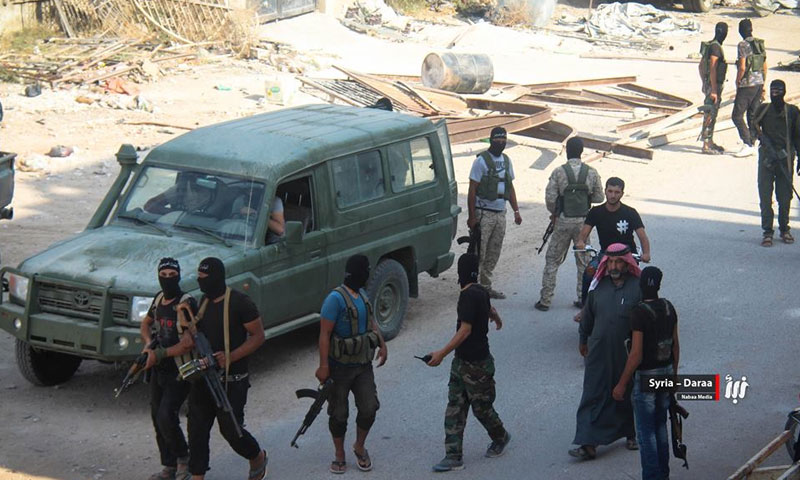The displacement of families and fighters in Beit Jinn differed from the process in other Syrian areas, for the destination chosen, for the first time, was the South. This resulted in a number of questions about the reasons for choosing the south as a destination for the displacement process, besides the north that received thousands of Civilians and fighters in the past a few years.
After the evacuation of the city of Darayya, the successive fall of cities and villages held by the opposition in the western countryside of Damascus took an accelerating tempo. Assad’s forces arrived at the opposition’s final stronghold in the western countryside of Damascus, which is Hermon area- known as Beit Jinn in the media.
The first segment of the fighters, who left the area, reached Idlib and Daraa on December 30. In five buses, about 150 fighters, accompanied by 50 civilians, arrived at the eastern countryside of Daraa.
Nevertheless, the number of the fighters who reached northern Syria is not yet specified amidst speculations that estimate the number of the arrivals as 120 fighters only while families are all in the town of Beit Jinn so far.
Different Characteristics
Beit Jinn, in relation to the areas of southern Syria which are held by the opposition, is distinct because it is only a few kilometres away from the opposition’s largest strongholds in the governorates of Daraa and Quneitra, a factor that enhanced the breakability of the siege over it, accordingly, the ability to change the battle’s military equation by indulging the factions of Daraa and Quneitra in its context.
In early November, the opposition factions, led by “Hay’at Tahrir al-Sham” (HTS), launched a battle under the name, “Breaking the Fetters over Hermon.” Through the battle, they sought to reach Beit Jinn via the regime loyalist town of Hader in rural Quneitra. The factions managed to control the targeted area for a few hours only before Assad’s forces, allied with Druze factions, managed to besiege the area again.
According to what a military source has told Enab Balad, despite the short period in which the siege was broken, the battle was affected and gave the opposition a chance to make some sort of a change after it managed to admit dozens of its fighters, from Daraa governorate, to support its presence.
“The battle, in southern Syria, meant a lot to Hay’at Tahrir al-Sham. For years, Al-Nusra Front sent professional and experienced staffs to the western countryside of Damascus, triggered by the area’s importance; it, thus, managed to establish a strong presence in Khan Alsheh and Beit Jinn, the reason that forced it to preserve that presence more than the other involved parties,” the source said.
When the battles reached Beit Jinn, “Tahrir al-Sham” had to use all its power to prevent the area from falling for Assad’s forces. Accordingly, it indulged dozens of its fighters in the battle of Hader town.
“When the siege was broken for the first time, despite the difficulty and the rigidity of the road, more than 130 fighters from Daraa governorate managed to enter to provide back up and continue the battle from the opposite side,” the source added.
Nonetheless, Assad’s forces hastened to reimpose the siege, which the source attributed to “regional agreements that implemented their role in preventing the liberation of the town of Hader and hampered the factions at the southern front from providing active assistance.” The battle, therefore, went to point zero with additional 130 new fighters in the besieged area.
Tahrir al-Sham Reattins its Fighters
Two months after this battle, under a persistent pressure from Assad’s forces, the regime managed to reach an agreement with the opposition factions to subject the area of Beit Jinn. Assad’s forces forwarded their, now customary, conditions: the surrender of weapons, the settlement of the fighter’s situation, the evacuation of the ones who refuse a settlement and sending them to Idlib exclusively, before Tahrir al-Sham would insist to reattain its Daraa fighters.
The source explained that “Tahrir al-Sham” has sent some of its best fighters to Beit Jinn and was keen to get them back to Daraa “due to its great need for them”. It succeeded in doing so on December 3o, for Daraa governorate has received a convoy of about 180 people, HTS’ fighters, in addition to a number of the fighters’ families. “Tahrir al-Sham” imposed security restrictions on the arriving families to prevent media coverage.
According to Enab Balad’s observations, 12 fighters from Daraa were killed in the battle of Beit Jinn, after they reached it to offer back up and were besieged, including Ayman al-Ta’ani, the military leader in “Tahrir al-Sham,” in addition to a similar number of wounded fighters.
The battle between these fighters and Assad’s forces does not seem to have ended, waiting for Assad forces’ next step after they managed to close the file of Western Ghouta completely, amidst signs that the coming confrontation in the Death Triangle is not that distant.











